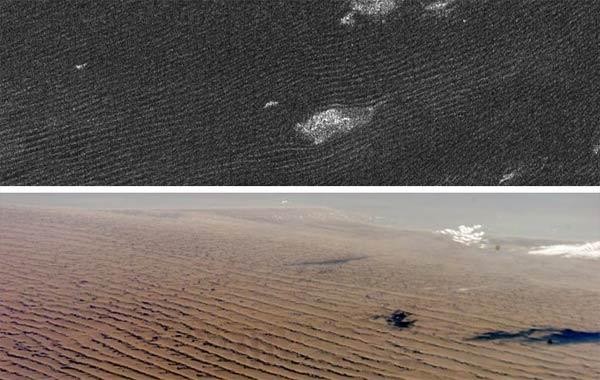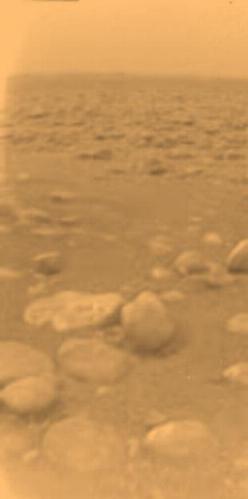It looks like you're using an Ad Blocker.
Please white-list or disable AboveTopSecret.com in your ad-blocking tool.
Thank you.
Some features of ATS will be disabled while you continue to use an ad-blocker.
30
share:
The Cassini probe had previously (about 10 years ago) found 300 foot-high sand dunes on Titan, but there were many mysteries about those dunes.
Scientists were not sure what was the source of the grains, nor how the winds could be strong enough to form the dunes, nor why the narrow shape of
the dunes seem to indicate that they were formed by winds moving the opposite direct that winds are believed to be moving on Titan (the dunes looked
to be laid out by westerly winds, while the winds on Titan blow easterly. They now think they have ideas about some (but not all) of the mysteries of
the dunes.
 Cassini radar sees sand dunes on Saturn's giant moon Titan (upper photo) that are sculpted like
Namibian sand dunes on Earth (lower photo). The bright features in the upper radar photo are not clouds but topographic features among the dunes.
Credit: NASA
Cassini radar sees sand dunes on Saturn's giant moon Titan (upper photo) that are sculpted like
Namibian sand dunes on Earth (lower photo). The bright features in the upper radar photo are not clouds but topographic features among the dunes.
Credit: NASA
Apparently, sand dunes are not that common in the solar system, which makes sense when you think about it, because there would need to be (1) solid materials to blow around and (2) Atmosphere and winds to do the blowing.
Also, it is believed that the sand isn't made up of silicates, but hydrocarbons and ice.
Titan is so cold that water ice there is as hard as rock. In fact, in the image below taken from the Huygens probe that landed on Titan (the only probe to ever see the surface up close), the visible rocks and boulders are thought to be boulders of water ice with a hydrocarbon coating.

While what the source of the grains are is still a mystery, but by modeling the conditions on Titan in a wind tunnel, scientists have discovered possible explanations about the speed of the winds required, and about the peculiar layout of the dunes. It turns out that scientist now think that the wind speeds need to be 50% faster than they previously thought they needed to be in order to move the sand. Their explanation for mystery of the wrong-way dunes also may help explain the higher than predicted winds.
Scientists found that there may be times that the winds on Titan shift direction from easterly to westerly. This happens twice during a Saturn year, which is 30 Earth-years, and during those times, the wind also moves faster -- fast enough (only then) to move the sand.
Sources:
Titan's 300-foot-high sand dunes were formed by westerly wind
Saturn's largest moon is a windy place: Titan dune puzzle solved

Apparently, sand dunes are not that common in the solar system, which makes sense when you think about it, because there would need to be (1) solid materials to blow around and (2) Atmosphere and winds to do the blowing.
Sand dunes have been found in just a few places throughout the solar system - on Venus, Mars, Earth and Titan - but Titan is the only moon where dunes have been discovered.
Also, it is believed that the sand isn't made up of silicates, but hydrocarbons and ice.
The sand that makes up Titan's dunes is not made of silicates like the sands we find on Earth, however. Instead, scientists believe it is made of hydrocarbons, and may include particles of water ice.
Titan is so cold that water ice there is as hard as rock. In fact, in the image below taken from the Huygens probe that landed on Titan (the only probe to ever see the surface up close), the visible rocks and boulders are thought to be boulders of water ice with a hydrocarbon coating.

While what the source of the grains are is still a mystery, but by modeling the conditions on Titan in a wind tunnel, scientists have discovered possible explanations about the speed of the winds required, and about the peculiar layout of the dunes. It turns out that scientist now think that the wind speeds need to be 50% faster than they previously thought they needed to be in order to move the sand. Their explanation for mystery of the wrong-way dunes also may help explain the higher than predicted winds.
Scientists found that there may be times that the winds on Titan shift direction from easterly to westerly. This happens twice during a Saturn year, which is 30 Earth-years, and during those times, the wind also moves faster -- fast enough (only then) to move the sand.
According to atmospheric models, the wind reverses twice during a Saturn year which is equal to about 30 Earth years. This reversal happens when the sun crosses over the equator, causing the atmosphere -- and subsequently the winds -- to shift. Burr theorizes that it is only during this brief time of fast winds blowing from the west that the dunes are shaped.
"The high wind speed might have gone undetected by Cassini because it happens so infrequently."
Sources:
Titan's 300-foot-high sand dunes were formed by westerly wind
Saturn's largest moon is a windy place: Titan dune puzzle solved
edit on 12/9/2014 by Soylent Green Is People because: (no reason given)
a reply to: Soylent Green Is People
If Titan is a Titan, then that doesn't look like Tennessee, to me.
Otherwise - very interesting & Thanks.
If Titan is a Titan, then that doesn't look like Tennessee, to me.
Otherwise - very interesting & Thanks.
Very interesting and informative! I've always found the makeup of Titan fascinating.
a reply to: Soylent Green Is People
Saturn has a crazy amount of radiation it gives off and a strong magnetic field, from an Eletric universe perspective they charge differential could be causing the dune like structures seen on Titan. Just like a magnet over iron particles shows the magnetic field this could be the same. It's the same thing creating the rings of Saturn by slowly etching the small moons around it creating more material.
Saturn has a crazy amount of radiation it gives off and a strong magnetic field, from an Eletric universe perspective they charge differential could be causing the dune like structures seen on Titan. Just like a magnet over iron particles shows the magnetic field this could be the same. It's the same thing creating the rings of Saturn by slowly etching the small moons around it creating more material.
originally posted by: NiZZiM
a reply to: Soylent Green Is People
Saturn has a crazy amount of radiation it gives off and a strong magnetic field, from an Eletric universe perspective they charge differential could be causing the dune like structures seen on Titan. Just like a magnet over iron particles shows the magnetic field this could be the same...
The dunes on Titan are only laid down in a westerly direction (as could be seen by the tear-drop shapes created around obstacles).
How does the electric universe theory explain this? Where are the magnetic lines of force that only run in such a way that sand grains are only deposited from a westerly direction?
The theory mentioned in the article gives a possible explanation why Cassini has never detected the strong westerly winds on Titan needed to produce these dunes: because perhaps they are a seasonal phenomenon, happening only twice every 29.7 Earth years (one Saturn year); therefore, Cassini has not had the occasion to be near Saturn during the times of the strong westerly winds.
How does the electric universe theory explain why the dunes are only laid from westerly direction? Titan has no magnetic field to speak of, but even if the magnetic lines of force are coming from another source -- say due to an electric universe -- then why do they only allow the sand grains to come from the west?
edit on 12/10/2014 by Soylent Green Is People because: (no reason given)
Awesome. I didn't know sand dunes were a rarity around our sun. I lived near some of the longest sand dunes in the Pacific Northwest for a few years.
I would say NiZZiM's theory about how the sand dunes are in their present shape seems logical.
new topics
-
Cold Blooded Killers on Christmas!! GRRRRrrr!!
Pets: 6 hours ago -
Plane Crash Today --Azerbaijanian E190 passenger jet
Mainstream News: 11 hours ago
top topics
-
Orange County Makes Shoplifting a Felony
Other Current Events: 15 hours ago, 17 flags -
It's Offical Now
US Political Madness: 17 hours ago, 15 flags -
Cold Blooded Killers on Christmas!! GRRRRrrr!!
Pets: 6 hours ago, 8 flags -
Plane Crash Today --Azerbaijanian E190 passenger jet
Mainstream News: 11 hours ago, 6 flags
active topics
-
Cold Blooded Killers on Christmas!! GRRRRrrr!!
Pets • 10 • : Flyingclaydisk -
Plane Crash Today --Azerbaijanian E190 passenger jet
Mainstream News • 14 • : Springbok -
London Christmas Market BANS Word ‘Christmas’
Social Issues and Civil Unrest • 50 • : Connector -
The clotting is not going away latest
Medical Issues & Conspiracies • 15 • : NoCorruptionAllowed -
Statements of Intent from Incoming Trump Administration Members - 2025 to 2029.
2024 Elections • 54 • : WeMustCare -
DefCon Teetering on Escalation
World War Three • 51 • : WeMustCare -
-@TH3WH17ERABB17- -Q- ---TIME TO SHOW THE WORLD--- -Part- --44--
Dissecting Disinformation • 3813 • : WeMustCare -
1 Billion dollars
General Entertainment • 13 • : ColeYounger2 -
It's Offical Now
US Political Madness • 15 • : Imhere -
Political Warfare & The Resister Special Forces Underground
Political Ideology • 2 • : NoCorruptionAllowed
30
